
Mosta is a small but densely populated city in the Northern Region of Malta. The most prominent building in Mosta is the Rotunda, a large basilica built by its parishioners' volunteer labour. It features the world's 3rd largest unsupported dome, and displays a replica of a German bombshell that famously crashed through the dome but did not detonate upon impact.

The Rinella Battery is a Victorian battery in Kalkara, Malta. It is commonly referred to as Fort Rinella, although it was never classified as a fort while in use. It was armed with an Armstrong 100-ton gun, which survives; the only other surviving gun is at the Napier of Magdala Battery, Gibraltar.
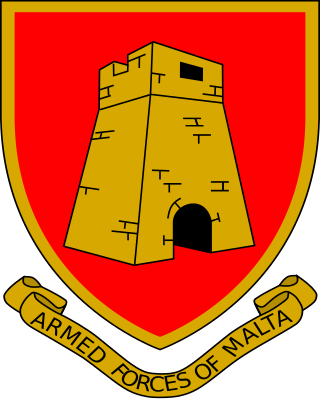
The Armed Forces of Malta is the name given to the combined armed services of Malta. The AFM is a brigade sized organisation consisting of a headquarters and three separate battalions, with minimal air and naval forces. Since Malta is the guardian of the European Union's most southerly border, the AFM has an active role in border control.

Fort San Lucian, also known as Saint Lucian Tower or Fort Rohan, is a large bastioned watchtower and polygonal fort in Marsaxlokk, Malta. The original tower was built by the Order of Saint John between 1610 and 1611, being the second of six Wignacourt towers.

The Victoria Lines, originally known as the North West Front, are a line of fortifications that spans 12 kilometres along the width of Malta, dividing the north of the island from the more heavily populated south.
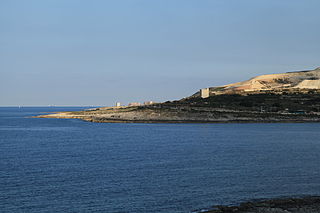
The De Redin Towers are a series of small coastal watchtowers built in Malta by the Order of Saint John between 1658 and 1659. Thirteen towers were built around the coast of mainland Malta, eight of which still survive.

The 100-ton gun was a 17.72 inches (450 mm) rifled muzzle-loading (RML) gun made by Elswick Ordnance Company, the armaments division of the British manufacturing company Armstrong Whitworth, owned by William Armstrong. The 15 guns Armstrong made were used to arm two Italian battleships and, to counter these, British fortifications at Malta and Gibraltar.

The Maritime Squadron of the Armed Forces of Malta is the naval component of the Maltese military. The Maritime Squadron has responsibility for the security of Maltese territorial waters, maritime surveillance and law enforcement, as well as search and rescue. It is based at Hay Wharf in Floriana.

Fort Tigné is a polygonal fort in Tigné Point, Sliema, Malta. It was built by the Order of Saint John between 1793 and 1795 to protect the entrance to Marsamxett Harbour, and it is one of the oldest polygonal forts in the world. The fort was extensively altered by the British in the 19th century, and it remained in use by the military until 1979.

The fortifications of Malta consist of a number of walled cities, citadels, forts, towers, batteries, redoubts, entrenchments and pillboxes. The fortifications were built over thousands of years, from around 1450 BC to the mid-20th century, and they are a result of the Maltese islands' strategic position and natural harbours, which have made them very desirable for various powers.

Żonqor Battery is an artillery battery in Marsaskala, Malta, standing on high ground overlooking Marsaskala Bay. It is a polygonal fort and was built by the British from 1882 to 1886.

Cambridge Battery is a Victorian-era battery in Sliema, Malta. It is commonly referred to as Fort Cambridge, although it was never classified as a fort while in use. It originally contained an Armstrong 100-ton gun.
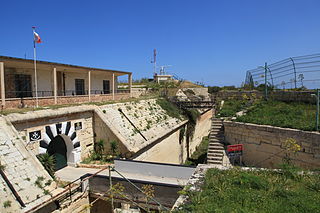
Fort Madalena, also known as Fort Madliena, is a polygonal fort in Madliena, limits of Swieqi, Malta. It was built between 1878 and 1880 by the British as part of the Victoria Lines. The fort now falls under the responsibility of the Armed Forces of Malta and is used by the St John Rescue Corps.

Fort Pembroke is a polygonal fort in Pembroke, Malta. It was built between 1875 and 1878 by the British to defend part of the Victoria Lines. The fort now houses the Verdala International School.
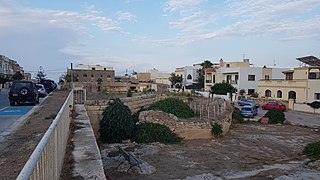
Pembroke Battery was an artillery battery in Pembroke, Malta, Malta. It was built by the British between 1897 and 1899, and most of it was demolished in the 1980s.

Fort Binġemma is a polygonal fort in the limits of Rabat, Malta. It was built between 1875 and 1878 by the British as part of the Victoria Lines. The fort has been illegally occupied by the Buttigieg family since 2009, who occasionally use it as a restaurant. It is set on a hill of around 180m above sea level. Before the building of the fort, there was a Roman village.

The Falca Lines, also known as the Falca Gap Entrenchment, are an infantry entrenchment in northern Malta, located on the limits of Mġarr and St. Paul's Bay. The lines were built in the 18th century by the Order of Saint John, and today lie in ruins.
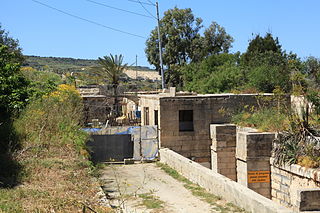
Tarġa Battery is an artillery battery on the boundary between St. Paul's Bay and Mosta, Malta. It was built in 1887 by the British as part of the Victoria Lines. The battery is now in the hands of the Mosta Local Council, who intend to restore it and open it to the public.

The RML 13-pounder 8 cwt gun was a British Rifled, Muzzle Loading (RML) field artillery gun manufactured in England in the 19th century, which fired a projectile weighing approximately 13 pounds (5.9 kg). "8 cwt" refers to the weight of the gun.

The Royal Malta Artillery (RMA) was a regular artillery unit of the British Army prior to Malta's independence. It was formed in 1889, having been called the Royal Malta Fencible Artillery from 1861 until 1889.





















